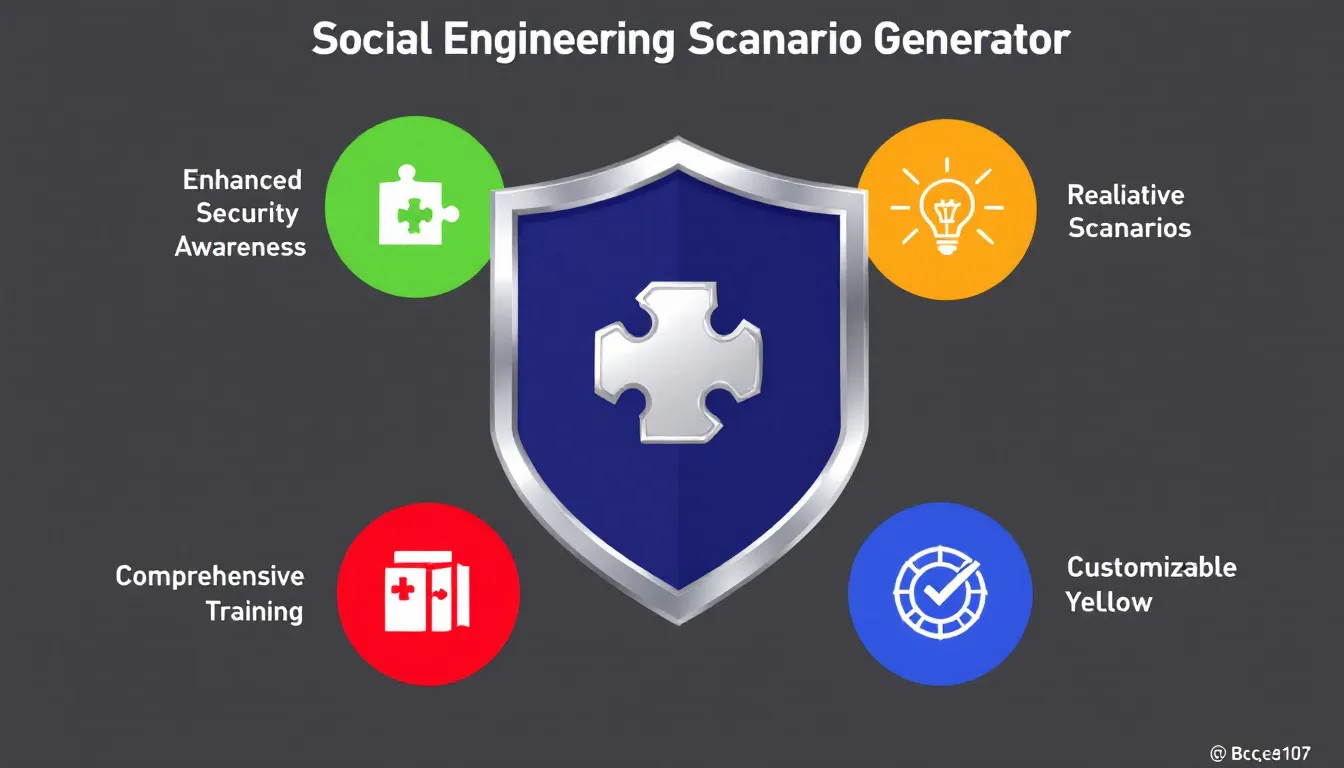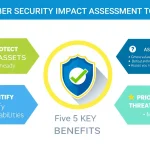Social Engineering Scenario Generator
Is this tool helpful?
How to Use the Social Engineering Scenario Generator Effectively
Follow these straightforward steps to create realistic social engineering scenarios tailored to your organization’s needs. This tool helps you design engaging training exercises that improve employee awareness and response to social engineering attacks.
-
Enter Organization Details: Describe your organization’s environment, focusing on industry, size, structure, and key operations. For example:
- “Global manufacturing company with 2,000 employees concentrating on automotive parts production and supply chain management.”
- “Non-profit environmental organization with 120 staff members working on conservation programs and policy advocacy.”
-
Identify Potential Social Engineering Threats: List the relevant social engineering attack types your organization faces. For instance:
- “Impersonation of vendors requesting invoice payments, social media reconnaissance, and baiting through USB drives in public spaces.”
- “Credential harvesting through SMS phishing, eavesdropping on conference calls, and physical impersonation of maintenance staff.”
- Generate Your Scenario: Click the button to receive a custom-crafted social engineering scenario based on your inputs, designed to reflect the specific risks your organization faces.
- Review and Analyze the Scenario: Study the generated scenario carefully to understand the tactics, attack methods, and possible impacts, helping you prepare targeted employee training.
- Share the Scenario: Easily copy the scenario text to distribute among your teams or incorporate it into your cybersecurity training programs.
Introduction to the Social Engineering Scenario Generator
The Social Engineering Scenario Generator creates tailored, practical training scenarios that help you prepare employees against real-world social engineering attacks. This tool uses your organization’s unique characteristics and threat landscape to craft situations employees might encounter, allowing them to practice recognizing manipulation tactics and responding correctly.
What Is Social Engineering?
Social engineering is the manipulation of people to gain unauthorized access or information, often leveraging human emotions like trust, fear, or urgency. Attackers use deceptive tactics such as phishing emails, fake phone calls, or impersonation to bypass technical defenses.
Why Tailored Scenarios Matter
Generic training doesn’t prepare your employees for the specific threats your organization faces. This tool generates customized scenarios based on your input, making training relevant and focused. Tailored exercises help employees connect the material to their daily roles and improve retention.
Practical Uses of the Social Engineering Scenario Generator
1. New Employee Orientation
Introduce new hires to the organization’s unique security challenges from day one with scenarios such as:
- Scenario: A new customer support specialist receives an urgent email from a supposed vendor asking for payment details, bypassing standard procurement channels. This tests awareness of proper verification steps.
2. Role-Specific Department Training
Design scenarios tuned to departmental risks and responsibilities. For example:
- Scenario for Human Resources: An attacker posing as an executive requests confidential employee data under the pretense of an internal audit, evaluating HR’s verification process.
3. Executive and Leadership Awareness
Prepare C-suite and board members with high-stakes scenarios targeting their access and influence:
- Scenario: A CEO receives a persuasive call from someone claiming to be from a trusted regulatory agency requesting immediate disclosure of sensitive financial documents.
4. Security Awareness Campaigns
Use generated scenarios for continuous engagement such as monthly challenges, gamified learning, or team discussions to reinforce good security habits.
5. Incident Response Drills
Develop multi-step attack simulations spanning several departments and communication methods to test your organization’s coordination and response speed during social engineering attempts.
Benefits of Using the Social Engineering Scenario Generator for Employee Training
Customized Training that Fits Your Organization
Tailored scenarios align with your company’s specific vulnerabilities and threat environment, making training more relatable and effective.
Boosted Awareness and Detection Skills
Regular exposure to realistic attack simulations sharpens employees’ ability to recognize and report suspicious behaviors before harm occurs.
Strengthened Incident Response
Practical exercises help teams practice decision-making under pressure, improving reaction times and reducing the impact of actual social engineering attacks.
Cost-Effective and Scalable Training
Generate an unlimited number of scenarios whenever needed, avoiding costly external consultants or standardized training materials that may lack relevance.
Continuous Adaptation to Emerging Threats
Keep your training programs current by generating new scenarios that reflect evolving tactics, ensuring repeated exercises remain relevant and challenging.
Addressing Organizational Challenges with Tailored Social Engineering Scenarios
Focusing on Your Industry’s Unique Risks
Different industries face distinct social engineering threats. For instance:
- Technology Company: Scenarios might simulate attackers impersonating software vendors to distribute malware or request sensitive source code access.
- Educational Institution: The tool could generate attacks featuring fake inquiries from supposed students or alumni to extract personal information or financial aid data.
Targeting Human Vulnerabilities
This tool highlights common weak points in employee behavior and awareness, so you can develop focused training programs to build a security-focused culture throughout your organization.
Preparing Employees for the Latest Threats
By incorporating current threat intelligence, scenarios help employees stay prepared against innovative social engineering methods, such as deepfake phone calls or sophisticated spear phishing.
Frequently Asked Questions About the Social Engineering Scenario Generator
How Often Should We Generate New Scenarios?
Generate new scenarios quarterly or whenever your threat landscape changes. Frequent updates keep your training fresh and effective against emerging tactics.
Can We Customize Scenarios for Different Departments?
Yes, input specific organization and threat details relevant to each department to create targeted scenarios that address their unique risks.
Are Generated Scenarios Based on Real Attacks?
Scenarios reflect common social engineering methods but are created to fit your organization’s context without exposing actual incident details.
Can We Modify the Generated Scenarios?
Absolutely. Use the generated scenarios as a starting point and customize them to best suit your training goals.
How Do We Avoid Causing Anxiety with Training Scenarios?
Present scenarios as learning opportunities focused on empowerment. Maintain open communication and provide support for employees who may find exercises challenging.
Should Employees Know About Simulated Attacks Ahead of Time?
Informing employees fosters transparency and encourages a proactive security mindset without reducing the effectiveness of training.
How Can We Measure Training Effectiveness?
Track improvements through metrics like decreased successful phishing simulations, increased incident reporting, and higher security assessment scores.
Does This Tool Support Compliance Requirements?
Many generated scenarios align with data protection and privacy regulations, aiding your compliance efforts when tailored appropriately.
What If Employees Struggle to Spot Attacks?
Use additional targeted training and mentorship to build skills gradually. Approach challenges with a supportive, educational mindset.
Using the Social Engineering Scenario Generator empowers your organization to build a vigilant, well-prepared workforce capable of defending against evolving social engineering threats. Tailor your training to real risks and continuously improve your human firewall.
Important Disclaimer
The calculations, results, and content provided by our tools are not guaranteed to be accurate, complete, or reliable. Users are responsible for verifying and interpreting the results. Our content and tools may contain errors, biases, or inconsistencies. Do not enter personal data, sensitive information, or personally identifiable information in our web forms or tools. Such data entry violates our terms of service and may result in unauthorized disclosure to third parties. We reserve the right to save inputs and outputs from our tools for the purposes of error debugging, bias identification, and performance improvement. External companies providing AI models used in our tools may also save and process data in accordance with their own policies. By using our tools, you consent to this data collection and processing. We reserve the right to limit the usage of our tools based on current usability factors.







